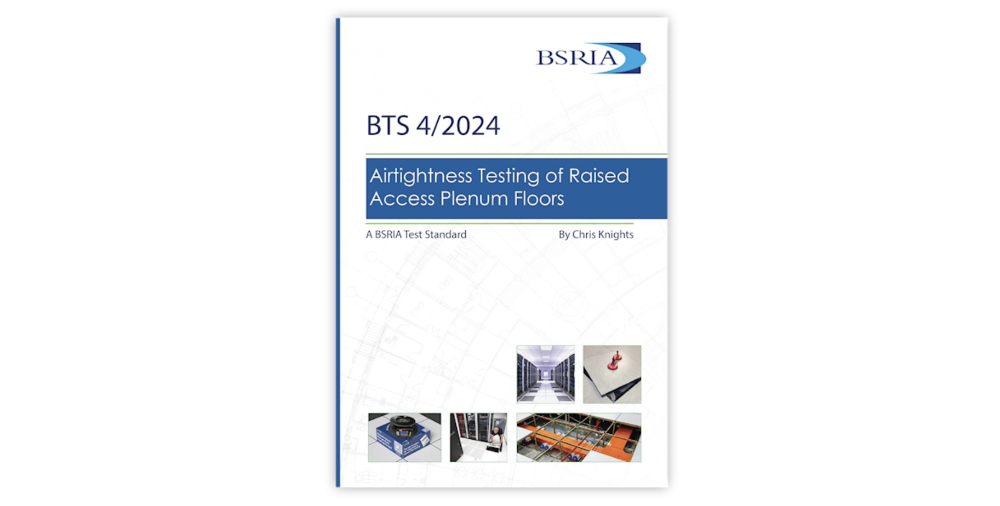Airtightness Testing of Raised Access Plenum Floors (BTS 4/2024)
A raised access plenum floor is a void between a building’s floor structure and the occupied space. This BSRIA Test Standard provides a methodology for testing raised access plenum floors and states limiting criteria for leakage. It supersedes BG 65/2016 Floor Plenum Airtightness – Guidance and Testing Methodology.
In response to stakeholder feedback to enhance and simplify the guide, BG 65/2016 Floor Plenum Airtightness – Guidance and Testing Methodology was superseded in 2024 by a new BSRIA Test Standard.
A raised access plenum floor is a void between a building’s floor structure and the occupied space, used for distributing conditioned air to the spaces above, consisting of two elements; the underfloor void and raised access floor. It is important that conditioned air in a floor plenum flows into the occupied zone and does not leak into cavities, risers, stairwells, heating trenches or other adjacent zones. A properly sealed raised access plenum floor will allow the diffusers and grilles to fulfil their primary role of delivering air at the correct flow rate. The airtightness of raised access plenum floors can be a serious energy efficiency issue.
This BSRIA Test Standard provides a methodology for testing raised access plenum floors. Limiting criteria for leakage from the underfloor void and raised access floor are provided, tailored to the challenges of smaller floor areas. Guidance on achieving both is provided. The testing methodology has also been enhanced to offer a complete process, eliminating the need to consult additional standards.
Specifying BTS 4/2024 can support an effective air distribution solution that aligns with design intentions for operational performance.
Revision History:
- Withdrawn: BG 12/2010 Floor Void Airtightness – Air Leakage Specification
- Superseded: BG 65/2016 Floor Plenum Airtightness – Guidance and Testing Methodology
- Current: BTS 4/2024 Airtightness Testing of Raised Access Plenum Floors
This article appears on the BSRIA news / blog and bookshop site as 'Airtightness Testing of Raised Access Plenum Floors (BTS 4/2024)' dated 01 December, 2024.
--BSRIA
[edit] Related articles on designing Buildings
- Airbrick.
- BSRIA articles.
- Displacement ventilation.
- Dynamic thermal modelling of closed loop geothermal heat pump systems.
- Earth-to-air heat exchangers.
- Floating floor
- Floating floors in buildings..
- Geothermal energy.
- Geothermal pile foundations.
- Ground energy options
- Ground preconditioning of supply air.
- Ground source heat pumps.
- Plenum.
- Raised floor.
- Thermal comfort.
- Thermal labyrinths.
- Underfloor air conditioning at London Grade II listed landmark.
- Underfloor air distribution UFAD.
Featured articles and news
Gregor Harvie argues that AI is state-sanctioned theft of IP.
Many resources for visitors aswell as new features for members.
Using technology to empower communities
The Community data platform; capturing the DNA of a place and fostering participation, for better design.
Heat pump and wind turbine sound calculations for PDRs
MCS publish updated sound calculation standards for permitted development installations.
Homes England creates largest housing-led site in the North
Successful, 34 hectare land acquisition with the residential allocation now completed.
Scottish apprenticeship training proposals
General support although better accountability and transparency is sought.
The history of building regulations
A story of belated action in response to crisis.
Moisture, fire safety and emerging trends in living walls
How wet is your wall?
Current policy explained and newly published consultation by the UK and Welsh Governments.
British architecture 1919–39. Book review.
Conservation of listed prefabs in Moseley.
Energy industry calls for urgent reform.
Heritage staff wellbeing at work survey.
A five minute introduction.
50th Golden anniversary ECA Edmundson apprentice award
Showcasing the very best electrotechnical and engineering services for half a century.
Welsh government consults on HRBs and reg changes
Seeking feedback on a new regulatory regime and a broad range of issues.
CIOB Client Guide (2nd edition) March 2025
Free download covering statutory dutyholder roles under the Building Safety Act and much more.

























